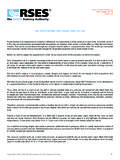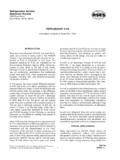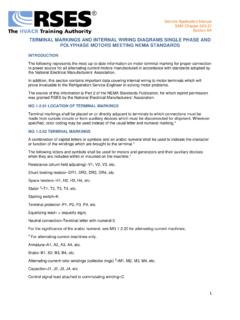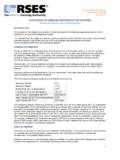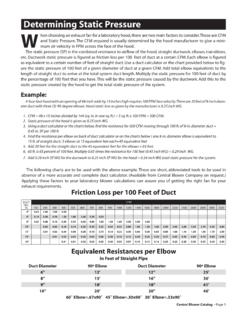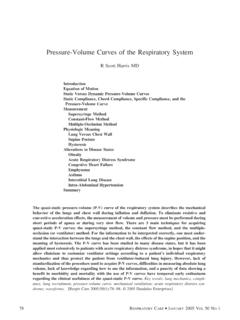Transcription of AN INTRODUCTION TO Static Pressure - RSES.org
1 RSES Journal NOVEMBER 2014 If you see duct pressures that exceed in. wc, rest assured there is a restriction somewhere on that side of the duct and properly measuring Static Pressure can provide clues as to why a system is not performing efficiently to quickly get HVAC units healthy again. Images courtesy of the DAVID RICHARDSONS tatic Pressure AN INTRODUCTION TO Measuring Static Pressure is a quick test that can help you evaluate an existing duct sys-tem and its installation conditions. Across the country this very day, equipment is unknowingly installed on drastically undersized duct sys-tems that hinder them from operat-ing to their full potential. By properly utilizing Static pres-sure testing, you can uncover prob-lems associated with this type of installation that are invisible to your competition.
2 You will find that once you begin to measure Static Pressure that there are more messed up duct systems than you will ever be able to correct. Consider how many of your service agreements include the duct system. Static Pressure 101 Static Pressure is the amount of Pressure a fan has to push and pull against to move air through a duct system. Static Pressure is exerted equally on all sides of a duct system. This Pressure is similar to that found by blowing up a balloon. When measuring Static Pressure , the unit of measurement used is inches of water column, which is often shown as an abbreviation such as in. wc, in. wg or in. H2O. One key to interpreting and diagnosing Static Pressure is to first understand how pressures change throughout an HVAC system.
3 Pressure on the supply side of the duct system will be highest at the discharge of the fan in the equipment. The lowest Pressure on the supply side of the duct system is usually found past the supply register as air enters a room. Pressure on the return side of the duct system will be highest at the inlet of the fan in the equipment. The lowest Pressure on the return side of the duct system is usually found right before air enters the return instrument used to measure Pressure is called a ma-nometer. The most common manometer is a Magnehelic gauge. The 0 1-in. wc Magnehelic gauge works perfect for most testing, including residential and most light-commer-cial testing. The top port of this gauge measures positive Pressure while the bottom port measures negative Pressure .
4 Another style of manometer is a digital manome-ter. For Static Pressure testing, make sure the manometer is equipped with two Pressure ports. Digital manometers should have a range from 0 in. to 5 in. and display Pressure to 1/100 of an inch. To complete the measurement of Static Pressure , you will need to have Static Pressure tips and tubing for making connections to the manometer. One manufacturer s Static Pressure tip is used to cancel out any effects of total pres-sure and velocity Pressure on the manometer resulting in inaccurate Pressure readings. You will also need 3/16- in. NOVEMBER 2014 RSES Journal When drill-ing test holes in equipment, using a drill bit sheath or step bit will help to avoid damage to electrical components, drain pans, coils and heat Pressure AN INTRODUCTION TO tubing for testing.
5 Neoprene tubing is a favorite of many who test Static Pressure on a regular basis due to how well it handles field steps/considerationsStatic Pressure testing normally requires five steps to complete: 1. Identify the locations you plan on drilling your test holes;2. Drill your test holes in the equipment and/or duct system;3. Take the needed Static Pressure readings;4. Determine total external Static Pressure and system Pressure drops; and5. Compare your Pressure readings to manufacturer s Pressure ratings or look for the component that has the highest Pressure drop to identify potential steps 1 and 2, you will need to drill test holes into the equipment and duct system in order to measure Static pres-sure.
6 To be safe, always use a drill bit sheath or step bit when drilling Static Pressure test holes in equipment. This will avoid damage to electrical components, drain pans, coils and heat exchangers. This also helps you avoid the dreaded hiss-ing sound made from a refrigerant line or coil that has been hit. Make sure you know what is behind your test location to prevent any unnecessary step 4, you will need total external Static Pressure and system Pressure drops. Total external Static Pressure is the total of pressures taken where air enters the equipment or suction Pressure ( ) and where air exits the equipment or discharge Pressure (+). These two pressures are then added together to indicate the total of the two Pressure forces that the fan has to push and pull against.
7 The + and signs represent the type of pressures found in these two locations, they are not mathematical symbols, so disregard the + and just add the two Static Pressure values together. Comparing this Pressure to the rated fan Pressure found on the equipment nameplate can tell you if repairs or modifications are needed to the system. This Pressure can also be used with manufacturer s fan performance data to approxi-mate the amount of air the air handling equipment is a gas furnace, pressures are typically measured after the air flow exits the filter and before the airflow enters the coil. With most gas furnace/split A/C systems, the coil and filter are excluded from the Pressure drop of the equipment. You can verify this in the manufacturer s engineering measuring the total external Static Pressure of an air handler, or packaged unit, the coil is included in the in-ternal Pressure drop specifications of the equipment by the manufacturer, just like a heat exchanger is on a concept that helps to understand where to measure total external Static Pressure is as shipped.
8 To apply this term, think about how the equipment comes from the fac-tory as-shipped in the box. What is included in the box as it is shipped from the factory? Once you have that answer, you will have a pretty good idea as to what is included in the to-tal external Static Pressure measurement for that piece of air-handling Pressure dropsThe possibility exists for many of the high-efficiency air fil-ters on the market today to degrade the performance of an HVAC system. These restrictive air filters have the potential to turn a 16-SEER system into a 10-SEER system. By mea-suring the Pressure drop over the air filter, you can identify if the filter is too restrictive for the application in which it is being Pressure drop of an air filter is found by measuring the Pressure on each side of the filter, then by subtracting the two pressures to find the Pressure difference.
9 Example: drill a test hole on each side of a filter, and measure the Pressure in each test hole. Say the Pressure before the filter measures in. wc and the Pressure after the filter measures in. wc. Subtract in. wc from in. wc to find the Pressure drop over the filter at in. wc. RSES Journal NOVEMBER 2014 You can compare the actual coil Pressure drop to the man-ufacturer s rated coil Pressure drop at the rated air flow to determine if the coil is clean. Measuring the Pressure drop over the indoor coil of an HVAC system is performed in a manner that is similar to measuring the Pressure drop of an air filter. Many service technicians will not perform this test as they are afraid of the methods involved with obtaining the readings since it in-volves drilling test holes in the equipment in certain instances.
10 Most equipment manufacturers unintentionally put holes in their equipment, so these can be utilized for Pressure testing if you know where they are. The coil Pressure drop is found by measuring the pres-sure on each side of a coil, and then subtracting the two pressures to find the Pressure difference. Example: drill a test hole on each side of the indoor coil, and measure the Pressure in each test hole. Say the Pressure before the coil measures in. wc and the Pressure after the coil mea-sures in. wc. Subtract in. wc from in. wc to find the Pressure drop over the coil is in. wc. One of the biggest mysteries with measuring the Pressure drop of an indoor coil involves knowing if the Pressure drop reading you obtained is acceptable.


